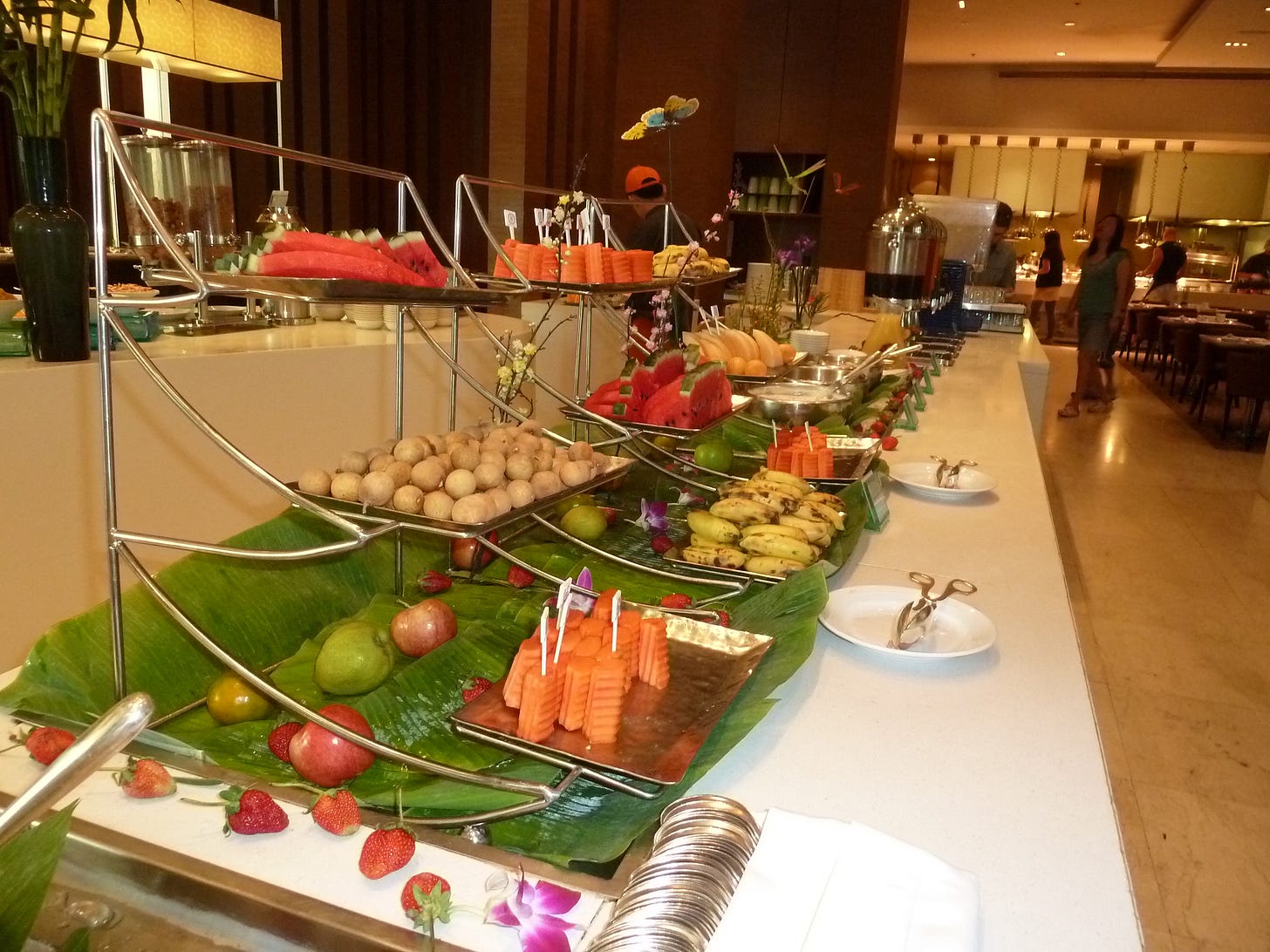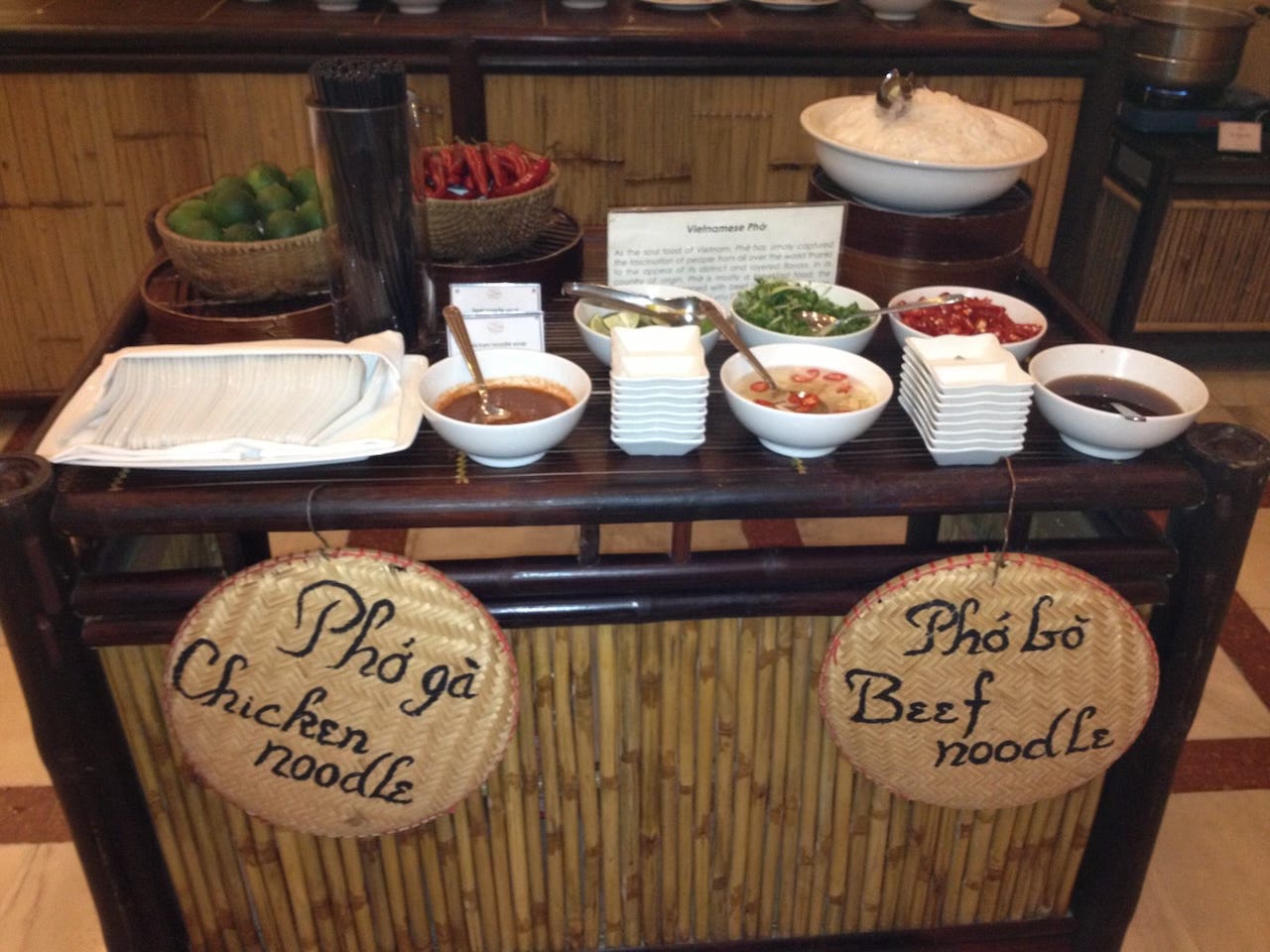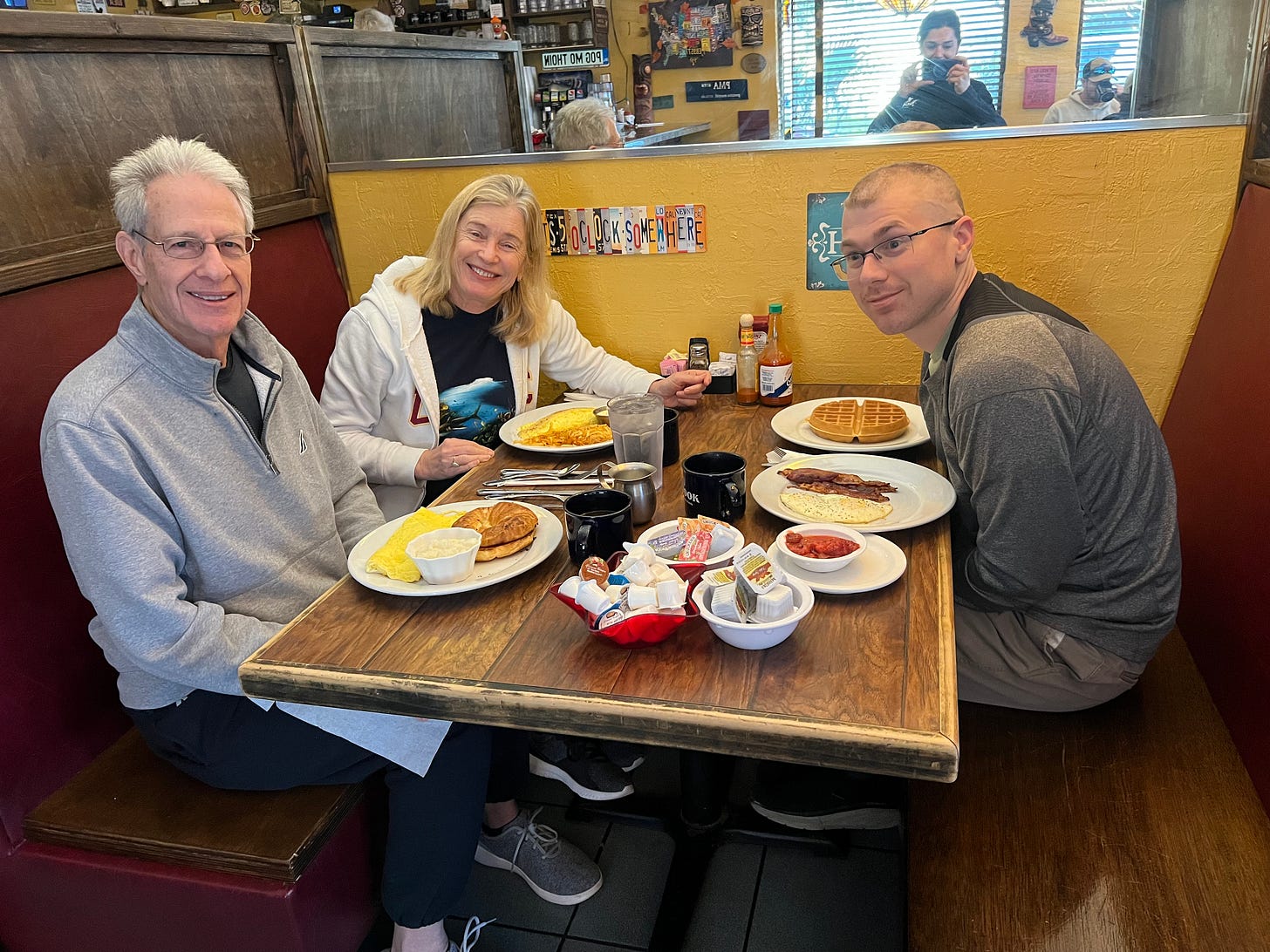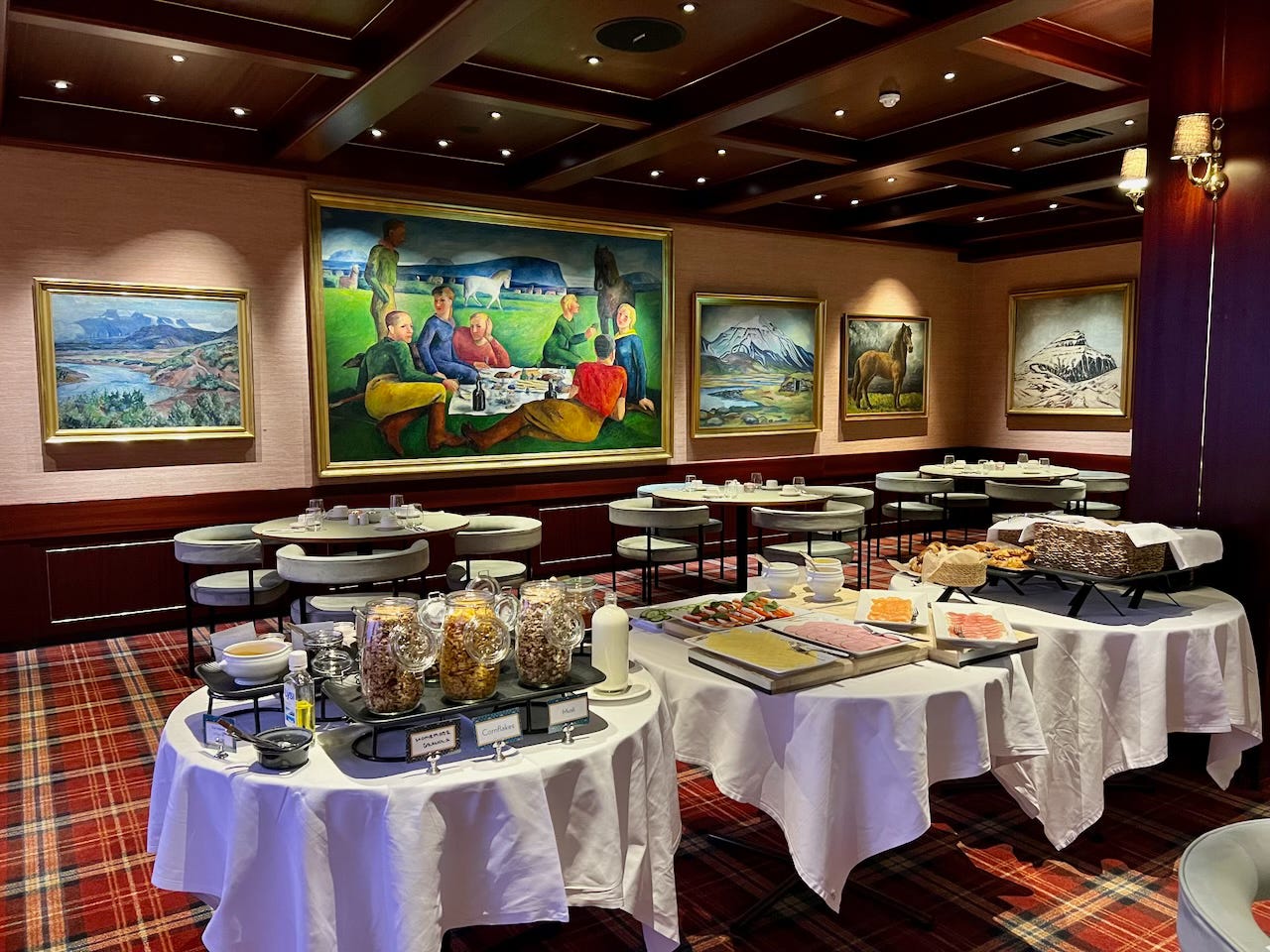The End of the Hotel Breakfast Buffet?
The shocking truth about what happens to the leftover food
I love a bountiful hotel breakfast buffet where I can sample the local food when I’m traveling. But what happens to the leftovers? In this edition of the FREE monthly travel newsletter:
The truth about breakfast buffets.
Praising the cooked-to-order American breakfast.
New on the Blog: What I did on a 3-day Iceland stopover.
In the news: RIP passport stamps, when to replace Air Tag batteries.
First, a reminder that this newsletter will always be FREE. I’m not like those other writers who make you pay to read the full article. So sign up, if you haven’t already, because you literally have nothing to lose. And you might plan some better trips. Or enjoy my random thoughts about other stuff. Like breakfast!

Are Breakfast Buffets Wasteful?
The question weighed heavy on my mind as I was enjoying the breakfast buffet at a Marriott hotel in Washington DC: “What happens to the leftover food?” I asked the cheerful server who brought my coffee.
Without batting an eye, she explained that health regulations require everything that’s not eaten by customers to be thrown in the trash. Apparently it’s a common practice, in the USA and around the world.
A writer for Euronews Travel visited a Melia Hotels property in Europe and observed the staff clearing the buffet tables: “To my shock, they wheeled in giant outdoor bins and began shovelling the food (off) of the platters directly into the bins. Most of the food was untouched and presumably fresh.”
It’s almost impossible to comprehend the amount of global amount of food wasted every year. A United Nations study in 2022 put the number at more than a billion tons.
Of course, there are many sources of food waste. But to put it on a more personal scale for travelers, a government report in Ireland found that people at a buffet wasted more than twice as much food (300 grams) as those ordering from a menu (130 grams).

Keeping Breakfast Sustainable
Cooked-to-order omelet stations are one way hotels reduce buffet waste, but they can’t do much about customers who load up their plates with more pretty pastries than they can eat. Some restaurants cancelled their buffets during Covid and never brought them back.
The Sailfish Marina restaurant in Palm Beach County, Florida simply moves its buffet food to a staff area when brunch for paying customers is over — just in time for the marina employees to help themselves to hot, fresh food for lunch. The fringe benefit is much appreciated by low-wage workers like the server who told me, “We eat really well.”
A few US states have tried to crack down on restaurant food waste, but the bans haven’t worked very well. So, it’s up to mindful travelers to do their part. Take only the portions you know you can eat. Or, better yet, choose the more sustainable option of a cooked-to-order breakfast. But don’t skip what’s often called the most important meal of the day!
If I’m embarking on a full day of city sightseeing on foot or hiking in the nature, a hearty breakfast is my best friend. I’ll work off the calories throughout the course of day. And I might even be able to skip lunch (or get by with a quick snack) because I won’t be hungry again until it’s time for an early dinner. Sightseeing through lunch hour is a great way to avoid crowds at some tourist attractions.

Let’s Praise the Big American Breakfast
To be honest, a Big American Breakfast is one of the things that I miss when I’m overseas. A hearty morning meal was necessary back in the day when work involved hard physical labor on farms and in factories, or maintaining a household without modern appliances. Small wonder that my husband’s favorite breakfast order usually has a name like “the hungry herder” or ‘the ranch hand.”
A full American breakfast is also a meal that is pretty hard to screw up. It doesn’t take a Michelin-starred chef to fry up some bacon with a couple of eggs, pancakes and french toast or a waffle on the side. Down-home diners and neighborhood coffee shops often do this food better than an overpriced hotel restaurant.
When it comes to sit-down service, breakfast tends to be a cheaper restaurant meal than lunch or dinner. In part because you’re probably not drinking alcohol — unless you’re into mimosas or bloody mary.

New on the Blog: Three Great Days in Iceland
An included breakfast was a great way to save money in a very expensive country. Read all about it in my new blog post. Besides finding out the top things to see in Iceland’s capital, you’ll find out how your stopover can be a FREE perk of your airline ticket to Europe or the US.
My favorite thing about Iceland is its geothermal spas. But if you only have time to visit one, which is best? I compare the Blue Lagoon and the Sky Lagoon in my new YouTube video. Click on this link to watch it.
In the News: No More Passport Stamps?
If a trip to Europe is in your near future, you’ll need to keep an eye on what’s happening with passport control for the Schengen Area. Those are the 29 countries in continental Europe that permit freedom of movement across borders.
Euronews reports that a new automated EES (entry/exit system) is supposed to go into effect on November 10. This is not guaranteed, because it was originally supposed to launch two years ago. Whenever it finally happens, you won’t be able to collect passport stamps anymore because the processing will be electronic.
This is supposed to reduce waiting time in the immigration line, but airlines are already whining that the airports aren’t ready for the change. So it might be delayed again, or not. Once the EES is in place, be ready for the new ETIAS European Travel Information and Authorization System. That’s just a fancy name for a document non-EU passport holders will need to pay for online before boarding the plane. (Similar to what the US has required of European tourists for years.)
Here’s the link to the EU’s official ETIAS website, which is not yet taking applications. The launch is scheduled for sometime in 2025. Avoid lookalike ETIAS websites that are trying to collect your information.
Time to Check your Air Tag Batteries
Hat tip to The Points Guy for reminding me to check my Air Tag batteries before my next trip. I forgot to put the Air Tag in my checked bag to Iceland. When Swiss Air re-routed me at the last minute, I had to worry about whether my bags would be transferred to the same plane that I was on. (They were, thanks to a really smart gate agent in Ljubljana.)
As you can read in my review of using Air Tags in Europe, knowing the whereabouts of my luggage is a real stress-reducer. Watch the video here for a taste of the helpful travel information that’s over on my YouTube channel.
The one time that my bags failed to make the connection in Frankfurt, I was able to track my stuff on its own adventure through Munich to the Ljubljana airport, spending the night in a neighborhood called Bežigrad before being delivered to my apartment.
Air Tag batteries last about a year and the “Find My” app on your phone should warn you when it’s time. Spend a few bucks for a compatible CR2032 coin-type lithium battery — cheaper than replacing the Air Tag. And Air Tags make a great gift for your favorite travel enthusiast, if you’re already shopping for the holidays.
See you next month. Don’t be a stranger!





Hi Heather. I'll be there first week in December. You will love Ljubljana's Festive Market!
I hadn’t realized that there was so much waste. And thank you for reminding me of my AirTag update. I’m heading for Slovenian Christmas markets at the end of November!